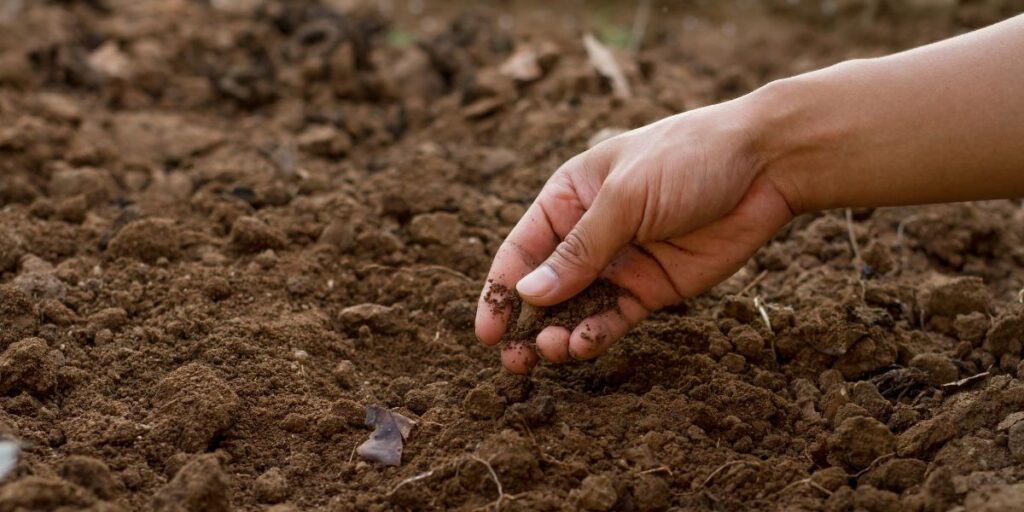Ahhh, feel that beautiful breeze and soak up the sun on your face.…winter is bowing out because spring has arrived! It’s time for the thing you’ve been dreaming of during the icy, cold months—gardening. Finally… We Outside!
Whether you were born with a green thumb or intend to trial-and-error your way into one, gardening is a great way to learn more about the earth, advance your mental health, and spend your time productively. Gardening is like free therapy with plants and insects as your therapist.
But to garden well, you need to create good soil for planting. What is good soil? What kind of soil do I need to garden? How do I get my soil ready for my garden?
Don’t worry, we’ve got all the ‘dirt’ on the topic you need!
Soil types
There are several soil types:
- Sandy
- Clay
- Silty
- Loamy
- Peaty
- Chalky
- Saline
These soils all have their own characteristics. Some have fine particles (clay soil) while others have large particles (sandy soil). Some soil types hold in water well but are easily waterlogged. Other, more dry soil types drain well but struggle to retain nutrients.
When preparing to garden, research your growing zone (a geographically defined area that helps gardeners determine which plants are most likely to flourish in the region’s climate). Also factor in where and how you will be planting your garden (raised bed or ground) and what type of plants you want to grow. If you are creating your own soil for pots or raised beds, you can choose what type of soil to use. If you are planting a garden in the ground, you will have to work with the soil as it is and add to it what is lacking.
Soil Evaluation
Before planting, take a moment to assess your soil visually and physically to determine what it may need to support healthy plant growth. Here are some easy ways to check your soil and improve it naturally:
- Texture Test: Grab a handful of moist soil and squeeze it in your palm.
- If it crumbles apart easily, it’s sandy and may need compost or organic matter to help retain nutrients.
- If it holds its shape but crumbles when poked, it’s loamy and well-balanced.
- If it stays in a firm, sticky ball, it’s clay-heavy and may need aeration, organic matter, or sand to improve drainage.
- Drainage Check: Dig a small hole (about a foot deep) and fill it with water.
- If the water drains quickly (within an hour), your soil may be sandy and need moisture-retaining additives like compost or mulch
- If it takes hours to drain, the soil is likely clay-heavy and can benefit from aeration and organic matter like compost or shredded leaves.
- Color & Smell:
- Dark, rich soil is typically healthy and full of organic matter.
- Pale or grayish soil may be low in nutrients and benefit from compost, manure, or natural fertilizers.
- A sour or rotten smell could indicate poor drainage and anaerobic conditions; turning the soil and adding organic matter can help.
- Weed Indicators:
- Certain weeds can reveal soil conditions. Dandelions and plantains thrive in compacted soil, meaning you may need to aerate. Clover growing abundantly suggests low nitrogen, so consider adding composted manure or a nitrogen-fixing cover crop.
How To Keep Your Soil Healthy
To maintain your soil structure, make sure you are aerating by loosening compacted soil with a garden fork. You want water and air to be able to move freely through your soil, helping the roots of your plants grow healthy and strong.
Soil pH balance is vital to healthy plant growth, and sometimes that pH gets out of balance and needs additional materials to come back into alignment. For soil that is too acidic (which is low pH), you can add lime to raise the levels back up to neutral, which will make the nutrients easier for your plants to absorb.
- For soil that is too alkaline (high pH), adding sulfur can lower that balance.
- Additionally, you can add rock dust (rock or mineral powders that carry trace minerals), and gypsum, which will improve soil structure and loosen up compact soils (this is especially helpful for heavy clay).
A good way for beginners to get started is with cans or pots. Start with a bag of potting soil or garden starter mix and then look online for any issues with your plants. You can search plant specific ailments and there are spot remedies that can be applied for your particular plant and problem. Our library of videos on starting, transplanting and troubleshooting issues can be found here: http://youtube.com/channel/UCpG10DzVACD5nXPSSnD1j3w
A good foundation for your garden starts in the soil, and while it can feel intimidating to “dig” into all the details, gardening can quickly become a way of life. By observing these signs, you can adjust your soil naturally, making it a welcoming home for your plants without the need for lab testing. Happy gardening!

